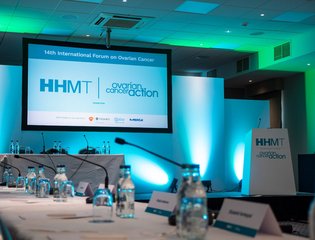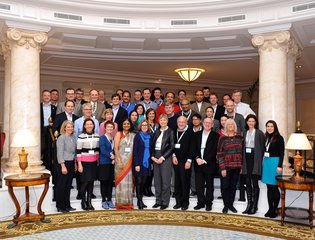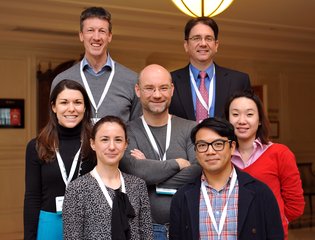The history of The HHMT international Forum on ovarian cancer

Helene Harris
London, 1984. Helene and John Harris were successful business people in their forties and fifties - people who knew how to make things happen. So, when Helene received a diagnosis of ovarian cancer, they were determined to seek the best treatment and the most experienced specialists to increase the odds of a cure.
One family decided to take action
John booked a flight to New York, where, sitting in the specialist’s office, he was surprised to learn that the UK and US had very different approaches to treatment. And that, between these two great, medically advanced nations, there had been no contact, no dialogue, no sharing of knowledge.
Despite their best efforts, within a few months of that visit, ovarian cancer sadly claimed Helene’s life. But even in grief, the Harris family’s first instinct was always to act.
Working through their grief
Together with their grown-up children, Allyson and Daniel, John resolved to set up the Helene Harris Memorial Trust (HHMT) International Forum on Ovarian Cancer. A foundation that would bring the world’s leading scientists together to pool knowledge, share best practice, determine the direction of research and publish its findings around the world.
Helene’s London specialist, Sir George Pinker, came on board as HHMTs first patron, and the first Forum was held in 1986. It was a storming success and paved the way for many successful meetings over the decades to come. The Forum has always followed the same model: four days of collegiate sharing, attended by the world’s leading scientists, all fired by the same cause and amplifying each other’s commitment - humanity, rigour and resolve.

HHMT
Helene's legacy continues
Over the first twelve years, the programmes covered every aspect of ovarian cancer - from science, diagnosis and treatment to early detection, the setting up of clinical trials, and epidemiology. HHMT published six books, which quickly became the first point of reference for specialists in all these fields – and remain on many bookshelves today.
Helene and John’s daughter, Allyson (now Allyson Kaye), who had been instrumental in the success and development of HHMT, was now right at the centre of the Trust’s work and vision. She decided to create her own charity, with the purpose to raise awareness and fund a research hub that would give a platform to the disease and everyone affected by it.
Ovarian Cancer Action quickly captured worldwide attention and attracted a broad range of funders. Within just three years, Ovarian Cancer Action raised enough money to establish its own research facility. In 2006, the Ovarian Cancer Action Research Centre (OCARC), Europe’s first ever centre dedicated to ovarian cancer research, opened its doors on the Hammersmith campus of Imperial College London, in research partnership with the Royal Marsden and the Institute of Cancer Research.
In another three years came another major breakthrough. After two decades of campaigning, the Department of Health finally gave its official recognition of the fact that ovarian cancer does have symptoms.
To date, Ovarian Cancer Action has funded £12.3 million of research projects and continues to fund research at its Centre and at other leading institutions around the UK.
We can make the quickest impact by raising awareness and the biggest impact through rigorous, collaborative, world-class scientific research.


